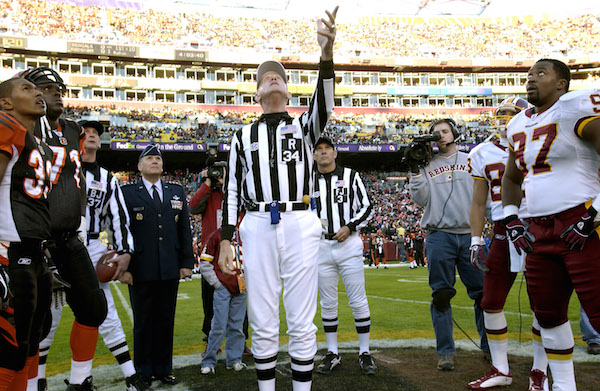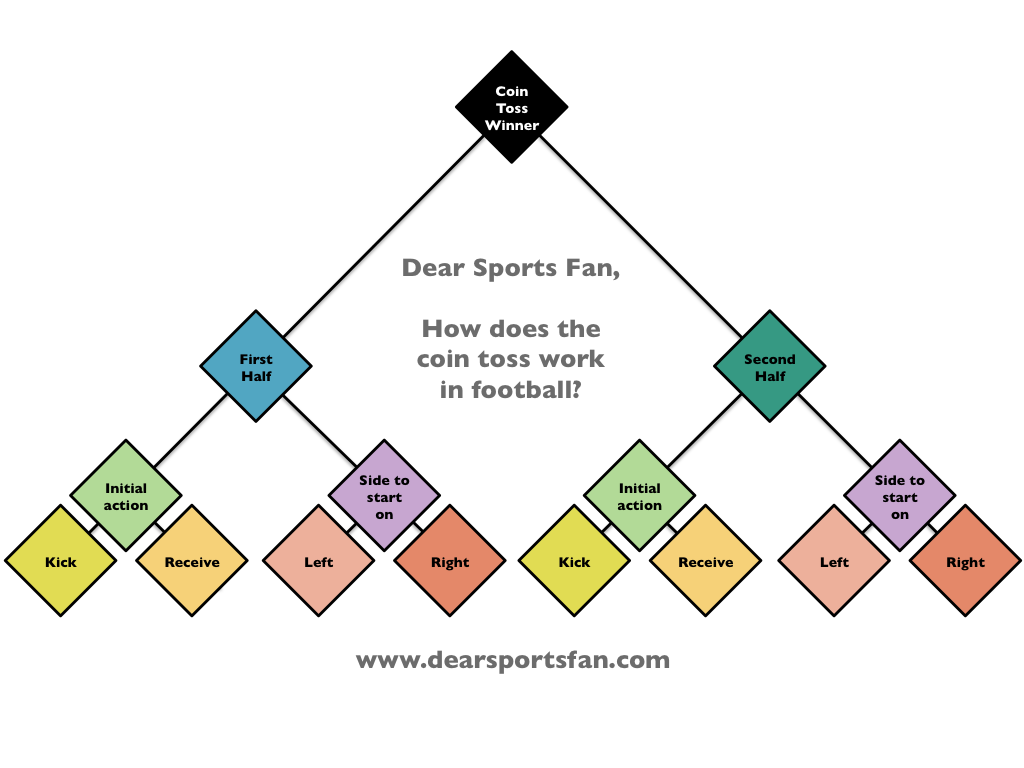Dear Sports Fan,
How does the coin toss work in football?
Thanks,
Tod
— — —
Hi Tod,
When I was a kid, I played a lot of soccer, and I was often the captain. The captain’s one job was to go to the center of the field before the start of the game and be a part of the coin toss. It was pretty simple: one team, I think the away team, called ‘heads’ or ‘tails’. Whoever won the coin toss could choose to select either whether they wanted the ball first in the first half or the second half OR they could choose which side of the field they wanted to start on. The other team got the choice which was left over. If you won the toss and took the ball, the other team got to choose which side they started on. If it was windy and you wanted to choose a side, they got to choose which half they started with the ball. Simple, right?
The NFL’s coin toss is a little complicated but it’s not so hard to understand. Take a deep breath and… here we go!
The coin toss helps facilitate a set of decisions that need to be made before the start of an NFL game and before the start of the second half. The decisions are as follows:
- Who kicks the ball and who receives the ball?
- Which side does each team play on. (The teams will switch sides between the first and second and the third and fourth quarters no matter what.)
Each time these decisions are made, one team gets first choice on one of them and the other team gets first choice on the other. So, if you choose who kicks and who receives, I get to choose which side I want to play on. To make things fair, one team will get to choose which decision to make first in each half.
The coin toss exists only to decide which team gets to choose which decision to make first in the first half versus the second half. The team that wins the coin toss gets to decide: do I want to choose first between kicking and having the side I want in the first half or the second? If they choose the first half, then they get to make that choice immediately. Would they like to kick or receive or would they rather leave that choice to their opponent in the first half and instead choose a side to start on. If the team that wins the coin toss decided they’d rather make that decision in the second half, that’s their right to decide. Choosing to choose in the second half is called “deferring.” Here’s a diagram that shows the set of choices the team that wins the coin toss has:
For more information, the official NFL rulebook is succinct and logical on the subject of the coin toss but not very understandable. Instead, I suggest the Wikipedia entry on the subject.
One of the things that’s interesting to me how the coin toss works in football is that it reveals something about the history of the game. Given the rules, one team could get the ball to start the first and second halves, if they choose to receive in one half and their opponent would rather choose a side to start on in the other half. It’s not necessarily the case, like in my youth soccer experience, that one team starts with the ball in one half and one in the other. This reveals that having the ball wasn’t always seen as an advantage. Football is often said to be a “field position” game, which means that it’s more important where the ball is on the field than who has it. That’s not really true anymore because offenses are so proficient at moving (or matriculating, to use a football cliché) the ball down the field. Now, most teams really do want the ball. In the old days though, football games often went back and forth, with each team having the ball, getting a first down or two, and then punting. If you don’t expect to get several first downs each time you have the ball, then it’s more reasonable to want to start half with your opponent in possession of the ball but way down at their end.
In today’s NFL, teams that win the coin toss almost always defer their choice to the second half. The losing team almost always chooses to receive the kickoff in the first half and the winning team almost always chooses to receive the ball in the second half. This is because it’s a winning strategy. In fact, according to this Bloomberg article, teams that won the coin toss had a .530 winning percentage in 2013. The fact that this has become so formulaic is actually part of why it’s hard to understand how the coin toss works in football. It seems like the team that wins the coin toss by rule gets to receive the kickoff in the second half. It’s more complicated than that but now you know how it works.
Thanks for the question,
Ezra Fischer



I myself, have some questions regards to the Coin Toss, actually a few.
Are the Coin Toss Rules and precedures Currently the same in both the NFL and College?
If I’m not mistaken, the Coin Toss in the NFL some years ago, was very simple. Whomever Kicked the Ball Off, also had the choice to select which direction or which Goal to Defend (North or South), for that Half. The 2nd Half, the same, so that made things less complicating.
Here are some of my questions, as follows;
Lets say USC is playing Auburn in the Rose Bowl, and USC Wins the Toss. Instead of Defering to the 2nd Half, SC elects to Receive the Ball. From what I have noticed, doesn’t the Leading Umpire then turn to and ask the Auburn Captains which Goal they will Defend?
That said, and done, we now know, Auburn will Receive to Start the 2nd Half (3rd qtr).
Now, who decides who will Defend what Goal to start the 3rd qtr?
Its my Understanding, that since USC would Kick the ball off to Auburn to Start the 2nd Half or 3rd Qtr, that SC would get the choice as to what Goal the Trojans would want to Defend, is this correct?
Last but not least, Since USC chose to Receive rather than Defer, I would assume this situation is Different to an extent than if USC chose to DEFER, is this correct?
Sorry if Ive confused you, as Im very confused how this all works.
Thanks and Fight On!
Earlier this 2014 season in an NCAA Football game, Texas played Ucla and made the mistake in the coin Toss that stuck them Kicking Off to Ucla not just once to start the 1st half, but the 2nd Half as well.
These situations, are why Id be afraid to Defer at all.
Not sure what was done to screw that up, but it was a Big screw up, that is for sure.
Anyone, who has great knowledge of this subject, Please feel free to explain how this works.
I apologize if I qualify for a Class in ‘COIN TOSS for DUMMIES 101.
Have a Nice and safe Holiday and NY in 2015, to all. Thank You.